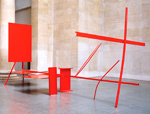Exhibition review: Modern British Sculpture at the Royal Academy
Country Life reviews an unusual interpretation of modern British sculpture at the Royal Academy


The majority of Britain's most famous artists have been painters rather than sculptors-Turner, Constable, David Hockney, Francis Bacon. Over the course of the 20th century, only two sculptors-Charles Wheeler in the 1950s and Phillip King in the 1990s were appointed presidents of the RA, and, in major public galleries, exhibitions of sculpture were as rare as those of contemporary British painting are today. Like a parody from Animal Farm, the mantra seemed to be ‘2D good, 3D bad'.
This discrepancy has long been a grievance of the father of Modernism in Britain, Sir Anthony Caro, who has complained that ‘painters get to eat at the high table and sculptors with the tradesmen'. For years, he has been lobbying the RA to host a sculpture show to redress the balance. Now, it seems, his wish has been granted.
The hour for sculpture has dawned and, for the first time in 30 years, the RA has presented a major exhibition of British sculpture, featuring everything from Alfred Gilbert's portrait of Queen Victoria to an electric fire stuffed with a goldfish by Bill Woodrow. Except that this show is far from comprehensive. Where are the sculptures by Richard Deacon and Anish Kapoor? Why no mention of Antony Gormley or the Chapman Brothers?
The title of the exhibition is ‘Modern British Sculpture', so what are Jeff Koons (American), Kurt Schwitters (German) and Naum Gabo (Russian) doing here? The answer seems to be that this is not so much a survey of the subject as a selection of sculpture from Britain and around the world. The works are presented in the context of cultural themes-empire, landscape, colonial influences-with sculptures on show only where they pertain to the thesis.
The exhibition is arguably more interesting if eccentric-as a result of its obvious omissions, if only because these allow more space for the unusual. There is, for instance, a wonderful totemic carving made by the Chokwe tribe of the Congo, an example of the kind of African and Indian art, with its coupling of sex and religion, that inspired Jacob Epstein and Eric Gill. Tang dynasty pottery is here, too, as is work by Cornish potter Bernard Leach.
And then, a little further along, is a wall of sheets torn from The Sun's Page 3 in a work by Gustav Metzger, included, the curators state rather primly, to reflect ‘the pornography of journalism-a daily production'.
Julian Opie, most celebrated for his bright, cartoonish portraits, is represented in the show by an empty steel cabinet he made early in his career; Sarah Lucas by Portable Smoking Area, comprising a wooden box stuck, like a hairdryer, above a chair. The landscape section features one of Sir Anthony's most delicately balanced pieces, Early One Morning, strung out like birds on a wire.
Exquisite houses, the beauty of Nature, and how to get the most from your life, straight to your inbox.
Despite the inclusion of a number of iconic 20th-century works, such as Barbara Hepworth's Single Form and Lutyens's maquettes for the Cenotaph, a better title might have been ‘Influences On British Sculpture From Around The Globe', or perhaps even ‘What Is Sculpture?'. ‘We were more interested in interesting ideas than producing a straight survey and an expected exhibition,' says one of the show's publicists, and, in this respect, ‘Modern British Sculpture' is admirably true to its aim.
‘Modern British Sculpture' is at the RA, Piccadilly, London W1 (020-7300 8000; www. royalcademy.org.uk), from January 22 to April 7
Country Life is unlike any other magazine: the only glossy weekly on the newsstand and the only magazine that has been guest-edited by His Majesty The King not once, but twice. It is a celebration of modern rural life and all its diverse joys and pleasures — that was first published in Queen Victoria's Diamond Jubilee year. Our eclectic mixture of witty and informative content — from the most up-to-date property news and commentary and a coveted glimpse inside some of the UK's best houses and gardens, to gardening, the arts and interior design, written by experts in their field — still cannot be found in print or online, anywhere else.
